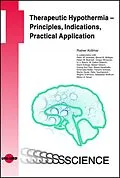The present publication provides information for the use of hypothermia in different types of human disorders including cardiac arrest, head injury, ischemic and hemorrhagic stroke, perinatal hypoxia, subarachnoid hemorrhage and spinal cord injury. In each of these cases, scientists and clinicians summarize peer-reviewed information that supports the use of hypothermia. This book, written by leading experts on hypothermia, is therefore interesting to a variety of readers including scientists, clinicians, nursing and other critical care investigators involved in therapeutic hypothermia and temperature management for the treatment of acute and progressive injuries. All chapters are clearly written and provide up-to-date references.
Inhalt
1.Definitions and Standardization of Terminology in Nocturia142.Prevalence and Bother of Nocturia182.1.Forewords of definition182.2.Prevalence192.3.Questionnaire versus frequency-volume chart in assessment of nocturia prevalence202.4.Bother of nocturia212.5.Conclusions233.Pathophysiology of Nocturia283.1.Urinary tract pathophysiology of nocturia283.1.1.Renal causes of nocturia283.1.2.Overactive bladder293.1.3.Benign prostate enlargement303.1.4.Neurogenic bladder313.1.5.Bladder pain syndrome313.1.6.Differential diagnosis323.1.7.Conclusions323.2.Nocturia and heart diseases353.2.1.Pathophysiology of nocturia in heart failure353.2.2.Management of heart failure413.2.3.Summary433.3.Nocturia and pulmonary diseases453.3.1.Association of nocturia and pulmonary disease453.3.2.Pulmonary hypertension453.3.3.Pulmonary mechanisms causing nocturia453.3.4.Pulmonary diseases associated with nocturia463.3.5.Summary524.Impact of Nocturia on Sleep and Quality of Life564.1.Impact of nocturia on Quality of Sleep564.1.1.Normal sleep564.1.2.Sleep, how much is enough?564.1.3.Sleep and age574.1.4.Insights into the consequences of sleep disturbance: proof from nocturia584.1.5.Conclusions604.2.Nocturia and impact on Quality of Life624.2.1.Definition of Health-Related Quality of Life (HRQoL)624.2.2.HRQoL The need for a reliable and valid instrument624.2.3.Disease-specific vs. generic questionnaires634.2.4.Is QoL worth assessing?634.2.5.QoL and nocturia644.2.6.Conclusion685.Assessment of Nocturia and Nocturnal Polyuria725.1.Nocturnal polyuria735.2.Decreased nocturnal bladder capacity745.3.Mixed nocturia755.4.Global polyuria756.Management of Nocturia and Treatment Algorithms806.1.Behavioural strategies806.2.Therapy for concomitant (non-urological) disorders816.3.Treatment of sleep disorders816.4.Pharmacological therapy for urological disorders816.4.1.Targeting the bladder or prostate816.4.2.Targeting the kidney antidiuretic therapy826.4.3.Gender differences during desmopressin treatment856.4.4.Combination therapy856.5.Prostate surgery866.6.Patient-related benefits of nocturia therapy866.7.Conclusions877.Outlook Future Developments in the Treatment of Nocturia927.1.The impact of definitions927.2.How do we measure nocturia and its impact?927.3.One symptom many causes937.4.What are meaningful treatment goals?937.5.Future treatments94Index95
Titel
Therapeutic Hypothermia - Principles, Indications, Practical Application
Autor
EAN
9783837453713
ISBN
978-3-8374-5371-3
Format
E-Book (pdf)
Hersteller
Herausgeber
Veröffentlichung
28.12.2012
Digitaler Kopierschutz
Wasserzeichen
Dateigrösse
4.93 MB
Anzahl Seiten
96
Untertitel
Englisch
Unerwartete Verzögerung
Ups, ein Fehler ist aufgetreten. Bitte versuchen Sie es später noch einmal.
